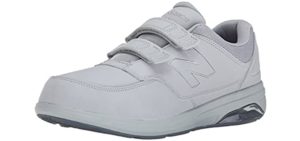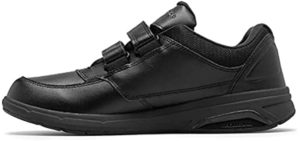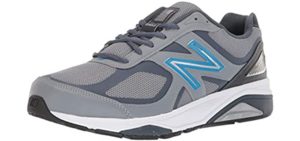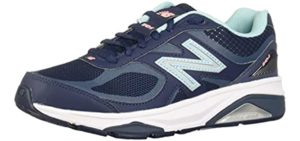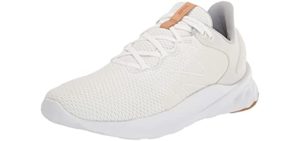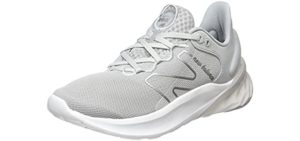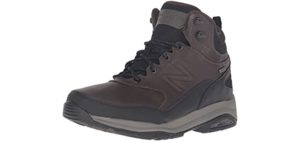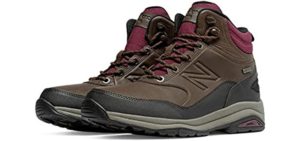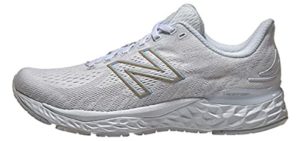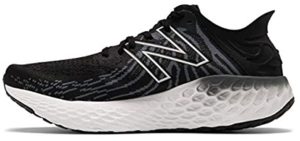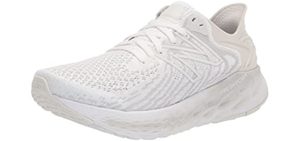Peroneal Tendinitis is a painful condition affecting the Peroneal tendon that runs along your outer ankle bone to your feet. You may have to wear a brace for the condition to heal in more severe cases. However, on the other hand, a simple orthotic device or proper footwear can help to reduce the symptoms, heal the condition, and prevent it in the future.
Most athletic shoes come with excellent support features that help with peroneal Tendinitis. For the most part, we will need proper arch support, stability, and good underfoot cushioning. You may also need a more accommodating shoe, should you need to wear a brace.
New Balance shoes for Peroneal tendinitis have been carefully selected according to their arch support features and cushioning features to reduce pressure and impact and help limit motion and accommodate orthotics.
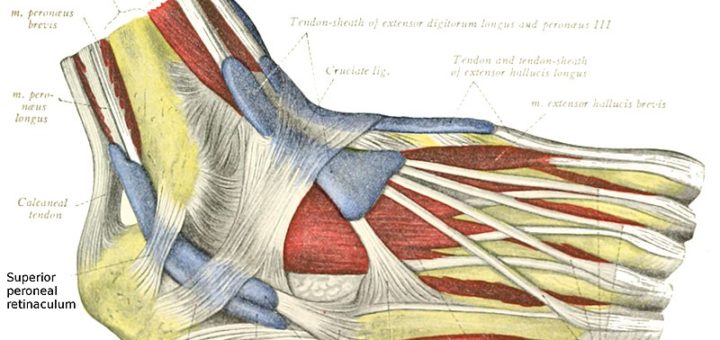
Peroneal Tendinitis Causes and Symptoms
You have tendons that run along the outer ankle bone at the side of your leg towards the sides of your feet. These tissues and tendons are called the Peroneal tendons. They connect your lower leg muscles to the bones in your feet.
When these tissues become inflamed or injured, you have Peroneal Tendinitis. Overuse or a sudden injury can cause it.
- Who Are at Risk – Anyone is at risk of getting Peroneal tendinitis. However, it is much more common in individuals that play sports involving plenty of ankle movement. Not stretching before an activity can place you at risk. Individuals over 40, or those with Diabetes or arthritis, who are overweight or have tighter than normal tendons, are also at risk.
- Causes – Peroneal Tendinitis may develop over time with repetitive overuse of the tendons during certain sports or activities. It can also occur during a sudden acute injury, such as an ankle sprain.
- Symptoms – You may have ankle pain that worsens during activity. There can be swelling and redness around the tendon or a mass or nodule forming where the tendon is.
Preventing and Treating Peroneal Tendinitis
Most of the time, if you have Peroneal Tendinitis, you will be given a brace to wear for at least two weeks.
You can use ice and stay off your feet for a while to prevent further pain and damage.
When choosing shoes to treat and prevent peroneal tendinitis, it is good to look for shoes with arch support that are more stable in terms of ankle support.
Features of a Good New Balance Shoe for Peroneal Tendinitis
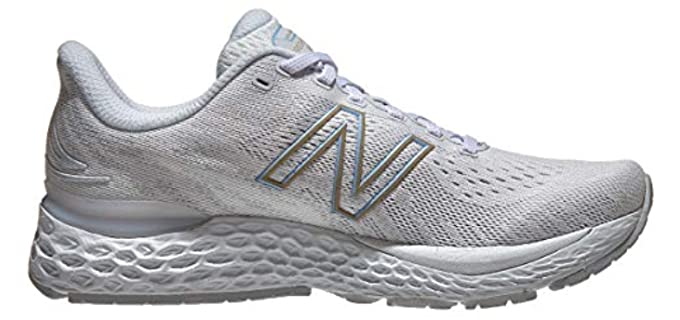
- Uppers – New Balance shoes may have either leather or mesh uppers, with some models that have knit uppers. They can have a roomy or more sleek fit. For support and stability, some models have a higher Ultra heel design or a padded collar with a snug heel fit. New Balance shoe models come with a smooth lining that reduces moisture and keeps your feet comfortable to prevent friction.
- Insole – Most New Balance shoe models will have either an NB softer insole or a Pu firmer foam insole that is removable, which allows you to use your orthotics. There are models with an Ortholite sock liner or a more molded insole for support.
- Midsole – generally, most Ne Balance shoes are designed with proper Built arch support. However, some models are more suited for certain foot types than others. Some models offer more firm and stable midsoles, and others have a more cushioned midsole for high arch types and neutral pronation. Because you want to Limit movement on the Peroneal tendons, I suggest light stability. Midsole options are the more flexible and versatile IMEVA and ACTEVA, the softer Fresh Foam and REVLite midsole, the firmer PU or ENCAP midsole, or the more shock-absorbing ABZORB midsole.
- Outsole – New Balance shoes mostly have a durable rubber, or high abrasion resistant Ndurance rubber outsole.
- Options – New Balance shoes are available in wider width options and many more color options from which you can choose.
- Support Features and Technology – The Medicare / HCPCS code = A5500 rated shoes from New Balance may be more suited should you need to wear a brace and may be eligible for Medicare reimbursement. There are also models with an internal midsole for better structural support.
Reviews: The Best New Balance Shoe for Peroneal Tendinitis
In our review section, we have chosen very specific New Balance shoe models that are ideal if you have Peroneal tendinitis or need extra protection to prevent the condition;
1
Peroneal Tendinitis Walking Shoe
- The New Balance 813 is a leather walking shoe with an adjustable hook and loop Velcro closure uppers.
- What I like about the design is that you can wear a brace with these shoes.
- They have rollbar technology for better stability and a removable Cardio Comfort Cushioned footbed.
- You can use your orthotics with this shoe, as it has an accommodating fit.
2
Shoes for Peroneal Tendinitis
- The 1540 Running shoes are ideal for preventing and further treating peroneal tendinitis.
- Because they are stability shoes, they control excessive rearfoot movement and have a Rollbar stability post.
- There is an ENCAP cushioned midsole that offers more supportive cushioning.
- The design of the footbed will support the arch.
- The uppers are synthetic and mesh for breathability.
3
Shoes for Peroneal Tendinitis
- If you are looking for softer comfort for Peroneal tendinitis, the Roav is ideal.
- The Fresh Foam midsole offers softer cushioning, and there are rubber outsole pods that absorb shock,
- The uppers are knit with a leather inset for structure, and a supportive heel is ideal for ankle support.
- The shoe does offer good arch support and has a stylish design for everyday wear.
4
Peroneal Tendinitis Trail Walking Shoes
- The leather boot from New Balance is ideal for Hiking, working, and outdoor walking.
- The longer shaft holds your ankle in place, ideal for peroneal tendinitis.
- It has a cushioned insole and midsole to absorb shock and a contoured footbed.
- The outsole is designed for all outdoor terrains.
- The uppers are durable and waterproof leather.
5
Shoe for Peroneal Tendinitis
- The 880 is an ideal running shoe if you have Peroneal tendinitis.
- The Molded footbed supports your arch, and the Molded heel counter controls your heel movement for stability.
- There is a Fresh Foam midsole that absorbs shock and provides soft cushioning.
- The uppers are mesh and synthetic that is comfortable and breathable.
6
Peroneal Tendinitis Running Shoe
- The Fresh Foam 1080 has a very thick cushioned sole with a slight rocker design that will take pressure off your feet for Peroneal tendinitis.
- It has synthetic and mesh uppers with a comfortable fit and roomy toe box.
- There is a thick and cushioned Fresh Foam midsole and an Ortholite sock liner for further comfort.
- The Ultra-Heel design hugs the back of your foot to prevent excessive and unwanted heel movement.
Index Table: Top Rated New Balance Shoe for Peroneal Tendinitis
| No. | Shoe | Men ♂ | Women ♀ | Features | Brand | Score |
|---|---|---|---|---|---|---|
| 1 | New Balance® - Peroneal Tendinitis Walking Shoe | 813V1 | 813V1 |
| New Balance | 98 |
| 2 | New Balance® - Shoes for Peroneal Tendinitis | 1540V3 | 1540V3 |
| New Balance | 97.8 |
| 3 | New Balance® - Shoes for Peroneal Tendinitis | Fresh Foam Roav V2 | Fresh Foam Roav V2 |
| New Balance | 97.8 |
| 4 | New Balance® - Peroneal Tendinitis Trail Walking Shoes | 1400 V1 | 1400 V1 |
| New Balance | 97.8 |
| 5 | New Balance® - Shoe for Peroneal Tendinitis | 880V11 | 880V11 |
| New Balance | 97.7 |
| 6 | New Balance® - Peroneal Tendinitis Running Shoe | Fresh Foam 1080V11 | Fresh Foam 1080V11 |
| New Balance | 97.5 |
Table of Contents
- Peroneal Tendinitis Causes and Symptoms
- Preventing and Treating Peroneal Tendinitis
- Features of a Good New Balance Shoe for Peroneal Tendinitis
- Reviews: The Best New Balance Shoe for Peroneal Tendinitis
- Index Table: Top Rated New Balance Shoe for Peroneal Tendinitis
